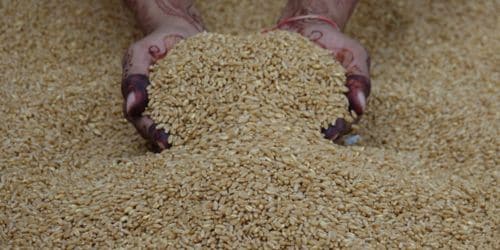Every month, hundreds of entrepreneurs enter the agricultural industry, with the majority focused on crop farming, others on processing, and very few only on commodities international trade. This mass agropreneurship movement expands the industry and helps to reduce unemployment while also facilitating economic growth. Sesame seeds farming is Nigeria’s second most important cash crop, after only cocoa.
In terms of the production of sesame seeds, Nigeria is now rated second in Africa and seventh in the globe.
The large global demand and potential income generated by sesame seed farming in Nigeria make it a vital agricultural sector for new and existing entrepreneurs to enter.
If you’re wondering how to start sesame seeds farming in Nigeria, this article will walk you through the steps.
What are Sesame Seeds?
Sesame seeds (Sesamum indicum), often known as benne seeds, are the seeds of a flowering plant in the Sesamum genus. These plants have lovely dark-green leaves and tubular flowers that can be white or pale pink. The mature plants can reach heights of 3 to 6 feet (depending on the cultivar).
Sesame seeds, which grow in pods or buns, are extensively grown in tropical places around the world. These tiny seeds are widely utilized for their scent, oil, and the health advantages they provide.
What is Sesame Seed Farming?
The production of the edible seeds of the flowering sesame plant is referred to as sesame seed farming. Sesamum indicum is the scientific name for sesame, which belongs to the Pedaliaceae family. Sesame is grown all throughout the world, including Nigeria and Africa, for its oil-rich seeds, which have a variety of uses in the food, pharmaceutical, and cosmetic industries.
Sesame seeds are high in nutrients such as healthy fats, protein, fibre, vitamins, and minerals, according to research. They also include bioactive substances like lignans and phytosterols, which have antioxidant and anti-inflammatory qualities that can help you stay healthy.
Sesame seed farming has the ability to provide 200-300 kg per hectare in terms of output in Nigeria and Africa. This can, however, vary based on factors such as soil quality, climate, and farming practices.
Sesame seed farming is an important agricultural activity in Nigeria and Africa, providing farmers with revenue and jobs while also contributing to the country’s economy. Nigeria is currently the world’s fourth-largest producer of sesame seeds, with an annual production of over 540,000 metric tonnes. The country sells sesame seeds to Japan, China, and Turkey. As worldwide demand for sesame seeds and products grows, Nigeria and Africa have a major chance to enhance sesame seed farming and exports.
The Advantages of Sesame Seed Farming in Nigeria
Sesame seed farming is a profitable agricultural operation with various advantages in Nigeria and Africa. Here are some of the most common advantages of sesame seed farming:
- High-yielding crop: Sesame seed is a high-yielding crop that can offer good harvests when properly cultivated.
- Nutritious: Sesame seed is high in vitamins, minerals, and antioxidants, making it a healthy addition to any diet.
- Cash crop: Sesame seed is a cash crop that can offer farmers with a consistent source of income while also boosting the Nigerian and African economies.
- Drought-resistant: Sesame seed is a drought-resistant crop that may be grown in areas with minimal rainfall.
- Pesticide-free: Sesame seed requires little pesticide use, making it an environmentally beneficial crop.
- Soil improvement: Soil fertility is improved by sesame seed farming due to the crop’s capacity to fix nitrogen.
- Multiple uses: Sesame seed has numerous use, including oil manufacturing, cooking, and flavoring in a variety of foods.
- Export potential: Nigeria is Africa’s largest producer of sesame seed, with great export potential to other countries.
- Job opportunities: Sesame seed farming provides employment for farmers and other agricultural value chain workers.
Types Of Sesame Seeds
On average, the globe uses roughly 3 million tons of sesame seeds per year, with Nigeria ranking seventh in terms of production and exportation.
There are three types of sesame seeds that can be identified:
#1. White Sesame Seeds
These are the most widely available sesame seeds on the market, and they are utilized in the production of baked goods and oils. They are edible without further preparation.
#2. Black Sesame Seeds
These seeds are well-known for their therapeutic properties, as they contain 60% more calcium than other varieties.
#3. Brown Sesame Seeds
Phosphorus, calcium, iron, and protein are all abundant in these seeds. These seeds are also higher in oil content than the others and are commonly used for oil extraction. They are often used in candies, baked goods, cereals, and other products.
Sesame seeds are good for your health since they include various essential nutrients and minerals that your body needs to function properly.
How To Start Sesame Seed Farming In Nigeria
To begin sesame farming in Nigeria, you must carefully follow the following steps:
#1. Select a suitable site.
First and foremost, choose a suitable place. This is critical because sesame seeds grow best in well-drained, fertile soil with a neutral pH. They thrive in dry circumstances but cannot endure waterlogged ones. For healthy growth and yield, the seeds need full sun. All of these criteria must be considered while deciding where to plant sesame seeds.
#2. Preparation of the Soil
The optimal pH range for growing sesame plants is 5.5 to 8.0. Sesame cannot be grown in soil that is acidic or alkaline.
1-2 ploughings and 2-3 cross-harrowings will be required to prepare the soil. During this period, apply all fertilizers. Add 10-12 kilogram urea and 40-50 kg superphosphate per acre for commercial production. Also, if the soil is insufficient, use MOP.
#3. Choosing and Purchasing a Variety
In different places of the world, there are several sesame types. It is best to choose a kind that is readily available in your area. SVPR-1, VRI-1, VRI-2, CO-1, TMV-3, TMV-4, TMV-5, TMV-6, and TMV-7 are some improved or hybrid sesame varieties. Make sure to check with an established farmer or an agriculture consultant in your area who may propose a nice variety.
After you’ve decided, go to your local market and get some high-quality seeds. You could also think about ordering the seeds online.
#4. Planting and Rates of Planting
Because sesame seeds are so few, you will need fewer seeds than you would for many other crops. In general, a proportion of 2-2.2 kg seeds will suffice for one acre.
Planting seeds in rows rather than dispersing them around the field is a much better alternative. Make sure the rows are around 10-12 inches apart. To ensure even dispersion, combine the seed with dry sand and scatter it along the furrows. Plant the seeds 1/2 to 2/3 inch deep. After sowing, cover the seeds with soil and lightly wet the soil.
You must treat the seeds with Bavistin at a dosage of 2 grams per kg seed before sowing. This will protect the seeds from disease transmission when the seedlings are about 4 inches tall, thin them to about 4-6 inches apart.
#5. Fertility, Water and Weed Management
In most circumstances, additional fertilizers are not required for growing sesame plants. Your crops will thrive just well if you have prepared the soil according to the instructions above. However, if necessary, use balanced NPK fertilizers.
Sesame seeds require less water than other oily seeds yet produce better yields with additional moisture. Heavy pre-irrigation is the best water the sesame seeds will ever receive after planting. Fast light irrigations would be preferred once the seeds germinate. Sesame seeds die from too much water.
Weed control is critical since they eat the majority of the nutrients in the soil. The initial step in weed management should be conducted while preparing the soil. Then, 15 to 25 days after spreading the seeds, extra weeding is required. Finally, 15 to 20 days following the first wedding, there will be another.
#6. Pest and Diseases
These are often lower in sesame plants, particularly in growing areas with current types. However, the most common pests you will encounter while raising sesame plants are caterpillars and gall bugs. Consult an experienced farmer or your local agriculture extension office for more assistance in controlling all of these pests and illnesses.
#7. Harvest and Yield
Depending on the type, sesame seeds are ready for harvesting 3-5 months after planting. However, most types can be harvested when the leaves, stems, and capsules turn yellow and the plant’s lowest leaves begin to shed.
It is not recommended to wait until the crop is completely mature because this will cause the seeds to shed. Ripe sesame plants should be trimmed at ground level and piled in the sun for 7 to 10 days to prepare for the threshing procedure.
Total production is always determined by the variety chosen as well as excellent farm management methods. In the autumn, expect between 200 and 500 kg per hectare. In the summer, 300-600 kg per hectare.
Types Of Equipment & Tools Used In The Sesame Seeds Farming
Processing and packing hulled sesame seeds in Nigeria and Africa necessitates the use of specialized equipment to assure quality and efficiency. The following items are required:
- Cleaning machine: Before processing, a cleaning machine is used to remove any impurities, dirt, or stones from the sesame seeds. It could be a vibrating sieve or a destoner.
- Hulling machine: This machine is used to remove the hull, which is the outer layer of the sesame seed. It can be either a mechanical or an automatic hulling machine.
- Roasting machine: This is used to roast sesame seeds before packaging in order to give them a distinct flavor and scent. It can be either a drum roaster or a continuous roaster.
- Grinding machine: This is used to ground roasted sesame seeds into a paste that can then be used to produce tahini, a popular Middle Eastern ingredient. It could be a traditional stone mill or a modern grinding machine.
- Packaging machine: This is used to pack hulled sesame seeds into various sizes of bags or containers. It could be either a manual or an automatic packing machine.
It is vital to remember that the equipment chosen is determined by the scale of production and the available budget. Manual or semi-automatic equipment can be utilized for small-scale production, whereas large-scale production necessitates more sophisticated and automated equipment.
Challenges Of Sesame Seeds Farming In Nigeria
The following are some of the obstacles to the expansion of the sesame seeds farming business in Nigeria:
- Infestation of pests: Sesame plants are susceptible to pest infestation, which can result in reduced yield and crop loss. Aphids, thrips, and whiteflies are common pests.
- Disease outbreak: Sesame plants are sensitive to diseases such Fusarium wilt, root rot, and leaf spot. These diseases can cause crop failure if they spread.
- Unpredictable weather conditions: Sesame plants need a warm, dry climate to grow, and unpredictable weather circumstances like drought, floods, or hailstorms can reduce crop productivity.
- Poor soil quality: Sesame plants demand well-drained, fertile soil. Low yield and nutritional deficits might result from poor soil quality.
- Inadequate irrigation: Sesame plants require proper moisture to grow, and insufficient irrigation can result in low yield and crop failure.
What is the Best Time to Plant Sesame Seeds?
Start sesame seeds indoors 4-6 weeks before the last spring frost date in most areas. Harden off seedlings before planting sesame seedlings outside 2-3 weeks after your last frost date. Warm soil is preferred by sesame. Sesame grows well in containers as well.
How Do You Start Sesame Seeds?
Plant seeds four to six weeks before the last frost date inside. Cover lightly with soilless planting mix. Keep moist until they germinate, then water once or twice a week. Sesame seeds sprout best at temperatures ranging from 68 to 75 degrees Fahrenheit.
What is the Best Way to Plant Sesame?
Place the seed 1/2 inch to 3/4 inch below the designated moisture line, with a dry covering of 1/4 inch to 3/4 inch above that line. The total seeding depth would be between 3/4 and 1.5 inches.
How Long Do Sesame Plants Take to Grow?
Physiological maturity (PM) is typically reached 95-110 days following planting. When 75% of the capsules on the main stem have developed seeds, it is called PM. The plant has a lot of leaves, but it will defliate when it matures. Sesame often dries after 120-150 days.
Which State Produces the Most Sesame in Nigeria?
Nigeria is Africa’s largest sesame seed producer, ranking only third in the world, and Jigawa state tops the country, officially making the state the continent’s highest producer.
Conclusion
Finally, sesame seed farming is a profitable business opportunity in Nigeria and Africa, with various advantages, including health and nutritional benefits, export potential, and a growing global demand for the commodity. Despite obstacles such as insufficient infrastructure, restricted access to finance, and climate change, the farming industry remains profitable and appealing to investors and entrepreneurs.
- Wheat Farming In Nigeria: All You Need To Know
- What is Commercial Farming? All You Need To Know 2023
- SEED FUNDING FOR STARTUPS: A Complete Guide
- BEST SAMSUNG BLACK FRIDAY DEALS IN 2023
- STARTUP FUNDING: What It Is, How It Works & Best Options






